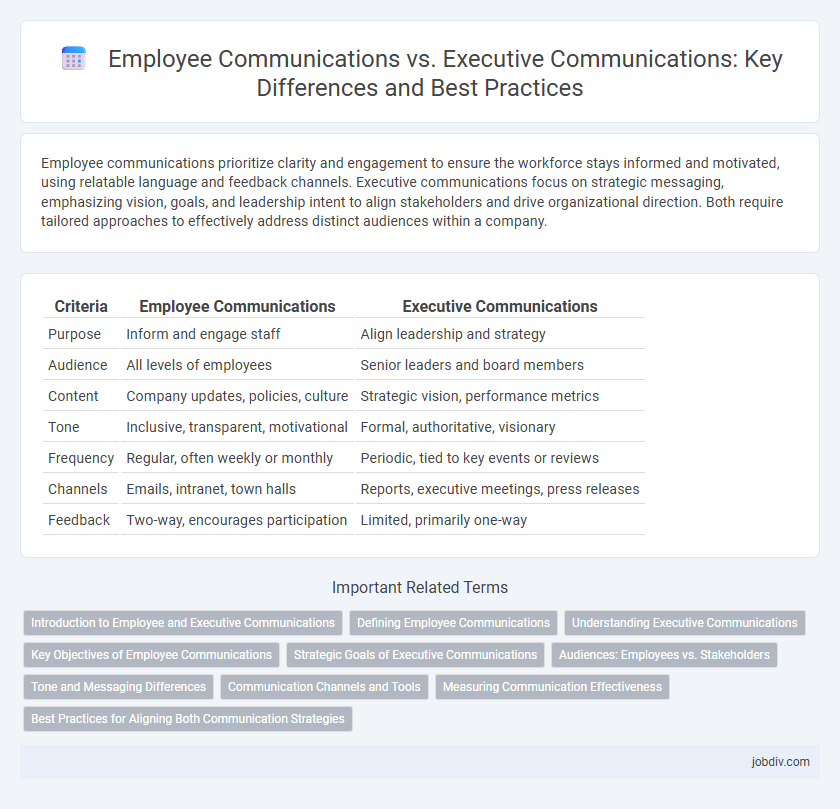Employee communications prioritize clarity and engagement to ensure the workforce stays informed and motivated, using relatable language and feedback channels. Executive communications focus on strategic messaging, emphasizing vision, goals, and leadership intent to align stakeholders and drive organizational direction. Both require tailored approaches to effectively address distinct audiences within a company.
Table of Comparison
| Criteria | Employee Communications | Executive Communications |
|---|---|---|
| Purpose | Inform and engage staff | Align leadership and strategy |
| Audience | All levels of employees | Senior leaders and board members |
| Content | Company updates, policies, culture | Strategic vision, performance metrics |
| Tone | Inclusive, transparent, motivational | Formal, authoritative, visionary |
| Frequency | Regular, often weekly or monthly | Periodic, tied to key events or reviews |
| Channels | Emails, intranet, town halls | Reports, executive meetings, press releases |
| Feedback | Two-way, encourages participation | Limited, primarily one-way |
Introduction to Employee and Executive Communications
Employee communications focus on delivering clear, consistent messages to staff at all levels, enhancing engagement, alignment, and productivity within an organization. Executive communications target senior leadership, emphasizing strategic vision, decision-making transparency, and influencing stakeholders both inside and outside the company. Effective communication strategies differ as employee communications prioritize clarity and inclusiveness, while executive communications require authority and persuasion to drive organizational goals.
Defining Employee Communications
Employee communications involve the strategies and channels used to share information, updates, and organizational goals with all staff members, ensuring alignment and engagement across various departments. This type of communication focuses on clarity, transparency, and fostering a collaborative culture by addressing employee concerns and promoting company values. Effective employee communications include regular newsletters, intranet updates, town hall meetings, and feedback mechanisms designed to enhance productivity and morale.
Understanding Executive Communications
Executive communications involve strategic messaging tailored to align leadership vision with organizational goals, ensuring clarity and influence across all levels. These communications prioritize transparency, consistency, and motivational tone to drive decision-making and foster trust among stakeholders. Understanding executive communications requires recognizing the importance of succinct, authoritative language that reinforces credibility and encourages employee engagement.
Key Objectives of Employee Communications
Employee communications primarily aim to enhance workforce engagement, ensure transparent information flow, and foster a collaborative culture by delivering clear, consistent messages tailored to employees' needs. Key objectives include promoting organizational alignment, supporting change management, and building trust through timely updates on company goals, policies, and benefits. These strategies drive employee motivation, improve productivity, and reduce turnover by connecting staff with leadership vision and corporate values.
Strategic Goals of Executive Communications
Executive communications prioritize aligning organizational messaging with strategic goals to drive leadership vision and influence stakeholder engagement effectively. They focus on delivering clear, consistent, and authoritative information that supports decision-making, fosters corporate culture, and reinforces business objectives. Employee communications, by contrast, aim to ensure two-way dialogue, boost morale, and enhance operational alignment across teams.
Audiences: Employees vs. Stakeholders
Employee communications target internal audiences, focusing on engaging staff, enhancing collaboration, and promoting company culture through transparent and consistent messaging. Executive communications address broader stakeholders, including investors, partners, and media, emphasizing strategic vision, corporate goals, and organizational performance. Tailoring communication styles and content ensures alignment with the distinct interests and expectations of employees versus external stakeholders.
Tone and Messaging Differences
Employee communications utilize a conversational and inclusive tone to foster engagement and clarity across various organizational levels, emphasizing transparency and collaboration. Executive communications adopt a formal and authoritative tone aimed at strategic direction and decision-making, often focusing on high-level objectives and company vision. Messaging in employee communications is detailed and practical, while executive messaging prioritizes succinctness and impact to align leadership and stakeholders.
Communication Channels and Tools
Employee communications primarily utilize internal platforms like intranets, email newsletters, and collaboration tools such as Microsoft Teams or Slack to facilitate day-to-day information sharing and engagement. Executive communications often rely on more formal channels including video conferences, keynote presentations, and company-wide town halls to convey strategic messages and organizational goals. Both communication approaches leverage digital tools but differ in tone, frequency, and audience targeting to maximize clarity and impact within corporate environments.
Measuring Communication Effectiveness
Measuring communication effectiveness in employee communications involves tracking engagement metrics such as open rates, feedback surveys, and behavior changes to ensure messages resonate and prompt desired actions. Executive communications require assessment through influence on organizational alignment, leadership visibility, and decision-making impact, often gauged via sentiment analysis and leadership feedback. Both communication types benefit from using analytics tools and performance indicators tailored to their distinct audiences to optimize clarity and strategic outcomes.
Best Practices for Aligning Both Communication Strategies
Aligning employee communications with executive communications requires consistent messaging, ensuring transparency and clarity across all organizational levels. Best practices include establishing regular feedback loops, utilizing multiple communication channels, and tailoring messages to address specific audiences while maintaining a unified vision. Leveraging data analytics to monitor engagement and adjusting strategies accordingly enhances alignment and fosters trust throughout the company.
Employee Communications vs Executive Communications Infographic

 jobdiv.com
jobdiv.com